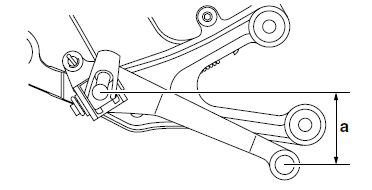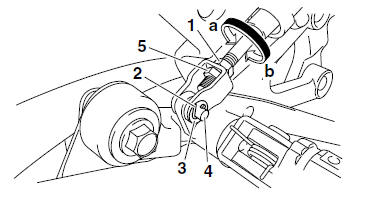Yamaha YZF-R125 Service Manual: Adjusting the rear disc brake
1. Check:
- Brake pedal position
(distance "a" from the center of the rider footrest
to the center of the brake pedal)
Out of specification
 Adjust.
Adjust.

2. Adjust:
- Brake pedal position
a. Loosen the locknut "1".
b. Remove the cotter pin "2", washer "3", and pin "4".
c. Turn the adjusting nut "5" in direction "a" or "b"
until the specified brake pedal position is obtained.

d. Tighten the locknut "1" to specification.
| WARNING A soft or spongy feeling in the brake pedal can indicate the presence of air in the brake system. Before the vehicle is operated, the air must be removed by bleeding the brake system. Air in the brake system will considerably reduce braking performance. |
| CAUTION: After adjusting the brake pedal position, make sure there is no brake drag. |
e. Install the pin, washer, and cotter pin.
| WARNING Always use a new cotter pin. |
 Chassis
Chassis
...
 Checking the brake fluid level
Checking the brake fluid level
1. Stand the vehicle on a level surface.
NOTE:
Place the vehicle on a suitable stand.
Make sure the vehicle is upright.
2. Check:
Brake fluid level
Below the minimum level mark "a" → ...
Other materials:
Specifications
Dimensions:
Overall length:
2015 mm (79.3 in)
Overall width:
660 mm (26.0 in)
Overall height:
1065 mm (41.9 in)
Seat height:
818 mm (32.2 in)
Wheelbase:
1355 mm (53.3 in)
Ground clearance:
155 mm (6.10 in)
Minimum turning radius:
3100 mm (122.0 in)
Weight:
With oil and fuel:
138.0 k ...
Installing the water pump
1. Install:
Water pump assembly "1"
O-rings "2"
NOTE:
Align the projection "a" on the impeller shaft
with the slit "b" on the camshaft sprocket bolt.
Lubricate the O-rings with a thin coat of lithiumsoap-
based grease.
2. Fill:
Cooling system
(with the specified amou ...
Genuine Yamaha Accessories
Choosing accessories for your vehicle
is an important decision. Genuine
Yamaha accessories, which are available
only from a Yamaha dealer, have
been designed, tested, and approved
by Yamaha for use on your vehicle.
Many companies with no connection to
Yamaha manufacture parts and access ...
